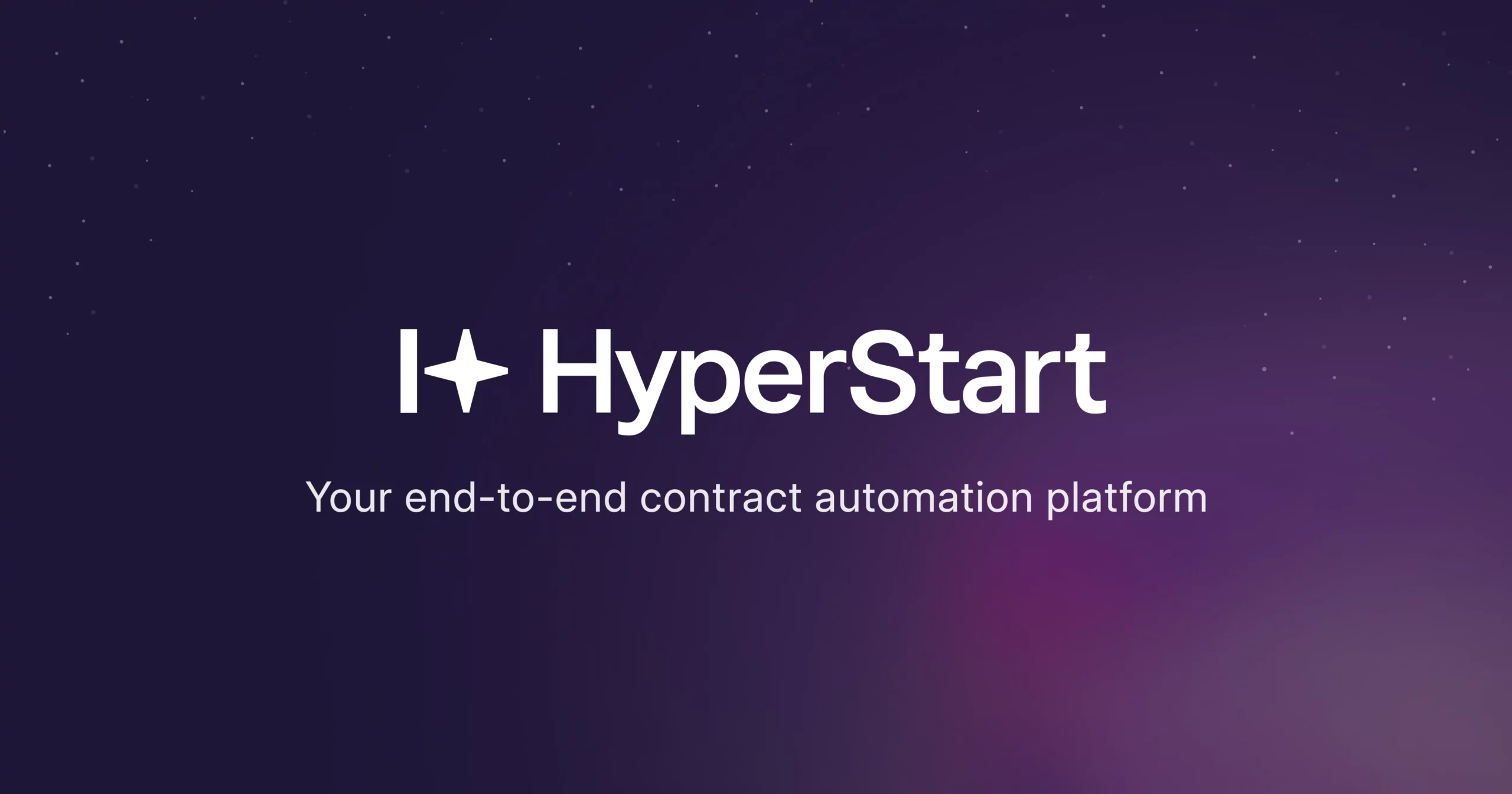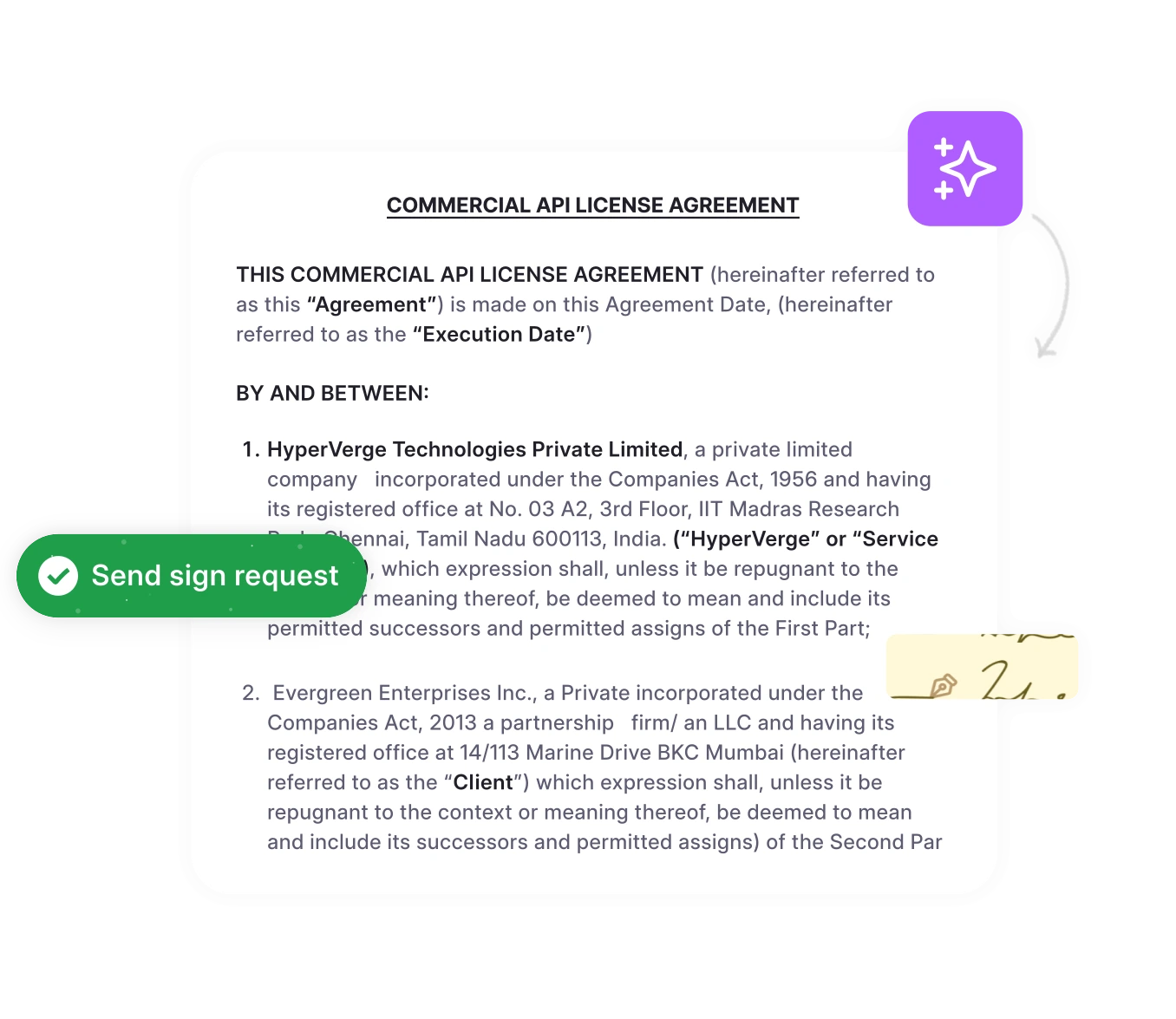Lending or borrowing money without proper documentation often leads to payment disputes, strained relationships, or even legal issues. A repayment agreement template helps prevent these issues by clearly outlining how and when the borrower will repay the lender — whether in personal, business, or employee-related scenarios.
From employee loan repayment agreements to business debt repayment contracts, these documents define repayment schedules, interest terms, and default conditions that protect both parties. More importantly, they turn informal promises into legally binding agreements that can be enforced in court if necessary.
This guide walks you through everything you need to know about repayment agreements — what they are, essential contract clauses to include, and how to create a custom repayment agreement template that fits your financial arrangement. You’ll also learn how platforms like HyperStart simplify contract creation, tracking, and compliance through automation — ensuring every repayment term is transparent, traceable, and error-free.
Your Complete Repayment Agreement Template – Get Now
Managing loan repayments, employee advances, or business financing without a formal agreement can lead to confusion, missed payments, and legal disputes. To simplify this process, HyperStart provides a comprehensive, ready-to-use repayment agreement template that’s tailored for businesses, HR teams, and financial managers.
This PDF template helps you:
- Clearly define the parties involved, repayment amounts, and contract schedules.
- Include interest, penalties, and default clauses to protect your financial interests.
- Provide legal enforceability and reduce potential disputes.
- Customize agreements for employees, clients, partners, or personal loans.
- Automate and track contract repayment terms efficiently when combined with HyperStart’s platform.
By using this template, you get a step-by-step, descriptive agreement that’s ready to use, complete with practical examples, amendment options, and guidance on best practices.
📥 [Get the HyperStart Repayment Agreement Template here]
Start formalizing your repayment processes today and protect your business and personal finances with a professional, legally sound agreement.
What is a repayment agreement?
A repayment agreement is a written contract that establishes the legal framework for debt repayment between a creditor and debtor. This payment contract serves as a binding document that outlines specific terms, conditions, and contract obligations for both parties involved in the lending arrangement.
Unlike informal IOUs or verbal promises, a properly structured simple payment agreement template creates enforceable legal obligations. The agreement specifies the amount owed, the payment schedule, the consequences of missed payments, and the remedies available to the lender. This legal clarity transforms a casual lending arrangement into a professional financial transaction.
What is a repayment agreement in practical terms? It’s your insurance policy against financial disputes, relationship damage, and costly legal battles that often arise from informal lending arrangements.
Scenario: Alexandre lends $3,000 to his colleague, Drake, to cover professional training costs.
Agreement Highlights:
This agreement ensures both Alexandre and Draft clearly understand the repayment terms, avoids disputes, and provides legal protection if obligations are not met.
When should you use a repayment agreement?
Creating a loan repayment agreement becomes essential in scenarios where money changes hands and repayment expectations are involved. These situations require formal documentation to protect both parties.
1. Personal lending scenarios
Personal loan repayment agreements are crucial when lending to family or friends. Financial disagreements can quickly damage personal bonds, so a well-structured, simple loan repayment agreement helps maintain relationships by establishing clear terms upfront.
Here are the most common personal lending situations:
Family financial assistance
- Down payment help for home purchases
- Emergency medical or legal expense coverage
- Educational funding for college or training
- Wedding or significant life event expenses
Friend-to-friend lending arrangements
- Financial aid during job transitions
- Vacation or considerable purchase funding
- Debt consolidation helps between friends
Even small amounts benefit from formal documentation, as it protects lender interests while providing borrowers with clear repayment expectations.
2. Business and employment contexts
Employee repayment agreements become necessary when companies provide advances for training, relocation, or emergency assistance to employees. These employee loan repayment agreements ensure that both parties understand the repayment terms, including the consequences if employment ends before repayment is complete.
Business-to-business lending also requires formal debt repayment agreements. Whether extending vendor payment terms or providing partnership financing, written agreements protect commercial interests.
3. Debt resolution circumstances
When existing debts become problematic, debt repayment agreements can restructure obligations into manageable plans. These arrangements often involve reduced amounts in exchange for guaranteed schedules, benefiting both parties while minimizing the risk of litigation.
What are the essential elements of a repayment agreement?
Every effective repayment agreement must include specific components to ensure legal enforceability and practical clarity. These elements work together to create a comprehensive framework that protects both parties and minimizes potential disputes.
| Essential Element | Required Details | Purpose and Benefits |
| Party Identification | Full legal names, current addresses, phone numbers, and email addresses | Ensures enforceability against the correct parties and enables future communication |
| Debt Amount Details | Total amount owed, breakdown of principal and charges, currency specification | Prevents disputes about debt legitimacy and provides a clear repayment target |
| Payment Schedule | Specific amounts, due dates, frequency, grace periods, and payment methods | Creates a clear timeline and expectations for both parties |
| Interest and Fees | Annual percentage rates, calculation methods, and late fee structure | Defines financial consequences and additional costs for delays |
| Default Provisions | Definition of default conditions, available remedies, and cure periods | Provides precise enforcement mechanisms and consequences |
Standard provisions of a loan agreement include its maturity, interest rate, and other key terms; all terms and conditions should be agreed upon by both sides.
Read
5 crucial requirements for effective documentation
Here are the 5 requirements that are essential for adequate documentation of a repayment agreement.
1. Complete party identification
Include full legal names, addresses, and business information. For entities, add tax identification numbers and details of the authorized representative.
2. Comprehensive debt documentation
Specify the total amount owed and itemize all components. Include original transaction details and any accrued fees or charges.
3. Detailed payment scheduling
Define exact amounts, due dates, and acceptable payment methods. Specify processing timeframes and payment crediting procedures for clarity.
4. Interest and fee structures
Ensure compliance with state usury laws. Clearly define calculation methods, compounding periods, and the timing of fee assessments.
5. Default and enforcement provisions
Include reasonable cure periods and define material versus technical violations. Specify available remedies and escalating enforcement procedures.
Is Contract Creation Overwhelming Your Team?
AI-powered contract management simplifies drafting with pre-built templates and automated workflows.
Book a DemoIf you negotiate a debt settlement, it’s essential to get the terms of your agreement in writing before you send any money.
Read
How to create a repayment agreement in 5 steps
Creating an effective repayment contract template requires systematic planning and attention to detail. Following a structured approach ensures that your simple payment agreement template includes all necessary elements while meeting legal requirements.
Step 1: Information gathering and documentation preparation
- Collect complete identification information for both parties, including legal names, addresses, and contact details
- Document the circumstances that led to the debt, including specific dates, amounts, and the purpose of the original transaction
- Gather supporting documentation such as invoices, receipts, or previous correspondence that establishes the debt’s legitimacy
- Verify business registration information and tax identification numbers for commercial transactions
Step 2: Financial capacity analysis and payment structuring
- Analyze the borrower’s income, expenses, and other financial obligations to determine realistic payment amounts
- Consider seasonal variations in income for businesses or individuals with variable earnings
- Structure payment amounts that challenge the borrower to prioritize repayment while remaining achievable
- Build in reasonable flexibility for temporary financial difficulties without compromising enforceability
Step 3: Legal language drafting and document preparation
- Use specific, unambiguous terms that leave no room for misinterpretation
- Follow proven contract drafting principles that ensure enforceability while maintaining clarity
- Avoid complex legal jargon that might confuse the parties, but ensure all essential legal elements are covered
- Structure the document logically with clear headings for easy reference
Step 4: Review, execution, and proper documentation
- Allow both parties adequate time to review the document carefully before signing
- Consider having signatures witnessed or notarized, particularly for larger amounts or complex arrangements
- Ensure each party receives a fully executed original copy of the agreement
- Create a clear record of when and where the agreement was signed
Step 5: Storage, backup, and ongoing management systems
- Maintain the original signed document in a secure, accessible location
- Create digital backups stored in multiple secure locations
- Establish systems for tracking payment due dates and monitoring compliance
- Set up procedures for handling late payments, modifications, or other issues that may arise
This process of writing a repayment agreement should result in a document that serves the interests of both parties while providing clear guidance for the entire repayment period.
What are the legal requirements for repayment agreements?
Understanding the legal framework surrounding repayment agreements ensures that your payment contract will be enforceable when needed. Legal requirements vary by jurisdiction, but fundamental principles apply universally to create binding financial obligations.
1. Contract law enforceability standards
Every debt repayment agreement must satisfy basic contract law requirements. Without these fundamental components, your agreement may be unenforceable regardless of how well it’s written.
- Offer and acceptance
One party proposes specific repayment terms, and the other agrees without coercion, creating mutual consent.
- Consideration
The original debt or loan that created the repayment obligation establishes a legal foundation for enforcement.
- Written documentation requirements
According to the World Bank, enforcing contracts through the courts takes an average of 581 days globally, highlighting the importance of written repayment agreements. The World Bank also reports that resolving disputes costs 21% of claim value when agreements are unclear.
2. State-specific compliance considerations
Contract payment agreements must comply with varying state laws that affect enforceability and collection procedures.
Usury and interest rate limitations
Many states establish maximum allowable interest rates and require specific disclosures for lending arrangements.
Consumer protection requirements
Personal loan repayment agreements may require specific language, cooling-off periods, or cancellation rights.
Collection law restrictions
States vary significantly in the remedies available, garnishment rights, and required notice procedures for enforcement.
Real-world court cases on repayment agreements
Summary:
In this foundational US Supreme Court case, a dispute arose when parties failed to honor a composition agreement involving repayment of promissory notes. The Court held that fulfilling repayment contracts is essential, and attempts to evade such agreements constitute a fraud upon other creditors. If a repayment agreement is documented correctly and consideration has passed, courts will generally enforce it as binding.
EU Mortgage Loan Case (C-70/17 & C-179/17, 2019)
Summary:
The European Court of Justice (ECJ) ruled that repayment clauses in mortgage agreements requiring full repayment in the event of a single missed payment could be unfair. If found so, the unfair clause must be removed, and national law may provide a replacement to protect the consumer from harsh consequences. This landmark decision demonstrates the European courts’ willingness to strike a balance between lender rights and consumer protection in repayment agreements.
To avoid such disputes and court cases, following best practices for repayment agreements is our best course of action.
What are the best practices for repayment agreements?
The financial impact of poor documentation is staggering. Data from the US Small Business Administration indicates that contract litigation costs small businesses over $105 billion annually in the United States, with much of this amount attributable to disputes over ambiguous or poorly documented payment agreements.
Clear and comprehensive written repayment agreements can significantly mitigate these costs. Professional documentation prevents the majority of disputes that lead to expensive legal battles. When parties clearly understand their obligations from the outset, compliance rates increase dramatically, and enforcement becomes more straightforward when necessary.
Core best practices for effective agreements
- Use precise, measurable terms throughout the document
- Include specific payment dates rather than vague terms like “monthly” or “quarterly”
- Specify exact payment amounts, acceptable payment methods, and processing instructions.
- Define interest calculations with clear compounding periods and rate specification.s
- Avoid subjective language like “reasonable payments” or “as soon as possible”
- Implement professional documentation and record-keeping standards.
- Maintain detailed payment records, including dates received, amounts, and payment methods used.
- Document all communications related to the agreement in writing, with dates and summaries
- Use standardized templates that ensure consistency and completeness across all agreements.s
- Create backup systems for all documents and payment records to prevent loss
- Include comprehensive default and remedy provisions.
- Define exactly what constitutes a material breach versus minor technical violations.
- Specify cure periods that allow borrowers to correct violations before serious consequences apply.
- Include acceleration clauses that make the entire balance due upon material default.
- Detail available remedies, including collection costs, attorney fees, and other enforcement options
- Establish proactive monitoring and communication procedures.
- Create systems for tracking payment due dates and following up on late payments promptly.
- Implement regular review procedures to identify potential problems before they become defaults.
- Maintain open communication channels that encourage borrowers to discuss temporary difficulties.
When negotiating with a debt collector, you should confirm whether you owe the debt, calculate a realistic payment plan, and make a repayment proposal to the collector.
Read
Sample loan repayment agreements should strike a balance between borrower capacity and lender protection through realistic yet firm terms that both parties can understand and consistently follow.
Is document management becoming unmanageable?
Centralized contract repositories make storage, search, and retrieval effortless for legal teams with HyperStart.
Book a Demo3 common mistakes that lead to disputes
Understanding frequent errors in repayment agreement creation helps you avoid problems that could make your financial agreement template unenforceable or difficult to implement. These mistakes often result from rushing the drafting process or failing to consider practical implementation challenges.
- Using vague or ambiguous payment terms that create confusion
- Imprecise language, such as “reasonable payments” or “when convenient,” allows for multiple interpretations.
- Missing specific due dates, payment amounts, or calculation methods that leave terms open to dispute
- Ambiguous interest calculations without specified rates, compounding periods, or application methods
- Unclear payment timing requirements that don’t specify deadlines or processing timeframes
- Setting unrealistic payment schedules that guarantee failure
- Ignoring the borrower’s actual financial capacity and existing obligations when structuring payments
- Creating overly aggressive payment terms that result in immediate default and defeat the agreement’s purpose
- Failing to consider seasonal income variations or business cash flow patterns in payment scheduling
- Establishing payment amounts based on wishful thinking rather than realistic financial analysis
- Omitting essential contract elements that create enforcement gaps
- Missing clear default definitions that leave enforcement triggers undefined
- Absent modification procedures that create uncertainty about how terms can be changed
- Lacking communication requirements for address changes or contact information updates
- Incomplete remedy specifications that limit enforcement options when problems arise
The contract ambiguity guidance explains in detail why vague or missing terms lead to disputes and enforcement issues that could have been avoided with proper attention to drafting.
An agreement to pay contracts can fail not because of legal deficiencies but because it ignores the practical realities of the repayment process. Payment processing logistics, communication procedures, and modification mechanisms require as much attention as legal terms to ensure successful implementation.
Streamline your repayment agreements with HyperStart.
Manual agreement management creates bottlenecks in template maintenance, approval workflows, and storage organization. Traditional email chains and spreadsheets struggle to manage employee repayment agreements and track complex financial contracts.
Benefits of automated contract lifecycle management include standardized template libraries that ensure consistency, automated approval workflows that eliminate delays, and intelligent search capabilities for instant agreement location. Real-time tracking prevents missed deadlines while financial system integration streamlines payment monitoring.
HyperStart – AI-powered contract management software transforms sample loan repayment agreement processes through pre-built templates, automated compliance checking, and centralized storage systems. AI-powered review identifies potential issues before they become problems, while automated workflows ensure consistent documentation across all repayment contract templates.The contract management team solution eliminates contract chaos for legal and business teams, reducing administrative burden while improving compliance and enforceability.
Ready to transform your agreement process?
HyperStart’s AI-powered platform eliminates contract chaos for legal and business teams.
Book a Demo










